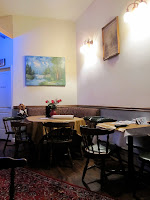 Located on the Adriatic Sea coast, there is also a wonderful Mediterranean influence that pervades the cooking.
Located on the Adriatic Sea coast, there is also a wonderful Mediterranean influence that pervades the cooking. Walking into the restaurant it felt like we were walking into someone's home. We were greeted by presumably Deta, a cute older Montenegrin woman who asked if we were hungry and led us to a table.
 What ensued was a conversation where she more or less told us what we were getting. That might sound ghetto, but what's fresh is fresh! She had a few salad options, 3 different bureks - spinach, sweet cheese, and meat - and then a gulaš. Ok!
What ensued was a conversation where she more or less told us what we were getting. That might sound ghetto, but what's fresh is fresh! She had a few salad options, 3 different bureks - spinach, sweet cheese, and meat - and then a gulaš. Ok!We began with a nice simple salad of red pepper, tomatoes, onion, and feta with balsamic, plus some nice rye bread. It is incredible how delicious just a few fresh ingredients can be!

Next was the gulaš, originally a Hungarian dish but now a mainstay in many European cuisines. The beef was nice and tender - plenty for the three of us to split. It was served with pasta, common in the former Yugoslavia, which was fine, but nothing to write home about.

Last but not least came a massive plate of burek, both the cheese and meat varieties. Burek itself is a flaky, baked (or fried) phyllo pastry filled with a variety of delicious fillings. Brought by the Ottomans centuries ago, burek is now a hugely popular dish in the former Yugoslavia, with the rolled variety being the most prevalent. The flaky, buttery pastry with the savory fillings is a wonderful combination, and it's fun to eat it piece by piece as the roll begins to come apart. Both of ours were delicious, but the slightly salty and crumbly baked feta-like cheese one was my favorite.
 Decently-full we still managed to find room for a small portion of homemade apple cake, which she brought out in three petite-sized tooth-picked slices. The cake was super-moist and the layer of apple was outstanding - just the right amount of sweetness.
Decently-full we still managed to find room for a small portion of homemade apple cake, which she brought out in three petite-sized tooth-picked slices. The cake was super-moist and the layer of apple was outstanding - just the right amount of sweetness.I'd love to come back here again and have a look at the real menu, just to see what else Deta has to offer! Anyone who's a fan of Greek, Turkish, or other Southeastern European cuisine, as well as anyone up for something new and fun should definitely give Deta's a try!








































 Our second day in Napa started out by Bry and I driving another way into Napa so we could see Sonoma Valley on the way. Sonoma has such a dynamic landscape, we both thought it was much better to go this way, over the Golden Gate Bridge, than over the Bay Bridge as we did the first day. Our agenda for day two was: Frog's Leap Winery, followed by Grgich Winery, lunch at Bouchon, then Stag's Leap Wine Cellars.
Our second day in Napa started out by Bry and I driving another way into Napa so we could see Sonoma Valley on the way. Sonoma has such a dynamic landscape, we both thought it was much better to go this way, over the Golden Gate Bridge, than over the Bay Bridge as we did the first day. Our agenda for day two was: Frog's Leap Winery, followed by Grgich Winery, lunch at Bouchon, then Stag's Leap Wine Cellars.









